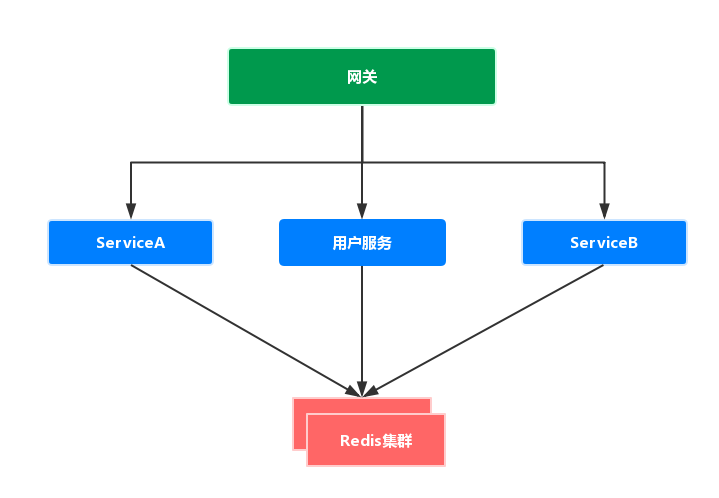
微服务架构

网关:路由用户请求到指定服务,转发前端 Cookie 中包含的 Session 信息;
用户服务:用户登录认证(Authentication),用户授权(Authority),用户管理(Redis Session Management)
其他服务:依赖 Redis 中用户信息进行接口请求验证
用户 - 角色 - 权限表结构设计
权限表
权限表最小粒度的控制单个功能,例如用户管理、资源管理,表结构示例:
| id | authority | description |
|---|---|---|
| 1 | ROLE_ADMIN_USER | 管理所有用户 |
| 2 | ROLE_ADMIN_RESOURCE | 管理所有资源 |
| 3 | ROLE_A_1 | 访问 ServiceA 的某接口的权限 |
| 4 | ROLE_A_2 | 访问 ServiceA 的另一个接口的权限 |
| 5 | ROLE_B_1 | 访问 ServiceB 的某接口的权限 |
| 6 | ROLE_B_2 | 访问 ServiceB 的另一个接口的权限 |
角色 - 权限表
自定义角色,组合各种权限,例如超级管理员拥有所有权限,表结构示例:
| id | name | authority_ids |
|---|---|---|
| 1 | 超级管理员 | 1,2,3,4,5,6 |
| 2 | 管理员A | 3,4 |
| 3 | 管理员B | 5,6 |
| 4 | 普通用户 | NULL |
用户 - 角色表
用户绑定一个或多个角色,即分配各种权限,示例表结构:
| user_id | role_id |
|---|---|
| 1 | 1 |
| 1 | 4 |
| 2 | 2 |
用户服务设计
Maven 依赖(所有服务)
<dependency>
<groupId>org.springframework.bootgroupId>
<artifactId>spring-boot-starter-securityartifactId>
dependency>
<dependency>
<groupId>org.springframework.sessiongroupId>
<artifactId>spring-session-data-redisartifactId>
dependency>
应用配置 application.yml 示例:
# Spring Session 配置
spring.session.store-type=redis
server.servlet.session.persistent=true
server.servlet.session.timeout=7d
server.servlet.session.cookie.max-age=7d
# Redis 配置
spring.redis.host=
spring.redis.port=6379# MySQL 配置
spring.datasource.driver-class-name=com.mysql.jdbc.Driver
spring.datasource.url=jdbc:mysql://:3306/test
spring.datasource.username=
spring.datasource.password=用户登录认证(authentication)与授权(authority)
@Slf4j
public class CustomAuthenticationFilter extends AbstractAuthenticationProcessingFilter {
private final UserService userService;
CustomAuthenticationFilter(String defaultFilterProcessesUrl, UserService userService) {
super(new AntPathRequestMatcher(defaultFilterProcessesUrl, HttpMethod.POST.name()));
this.userService = userService;
}
@Override
public Authentication attemptAuthentication(HttpServletRequest request, HttpServletResponse response) throws AuthenticationException {
JSONObject requestBody = getRequestBody(request);
String username = requestBody.getString("username");
String password = requestBody.getString("password");
UserDO user = userService.getByUsername(username);
if (user != null && validateUsernameAndPassword(username, password, user)){
// 查询用户的 authority
List userAuthorities = userService.getSimpleGrantedAuthority(user.getId());return new UsernamePasswordAuthenticationToken(user.getId(), null, userAuthorities);
}throw new AuthenticationServiceException("登录失败");
}/**
* 获取请求体
*/private JSONObject getRequestBody(HttpServletRequest request) throws AuthenticationException{try {
StringBuilder stringBuilder = new StringBuilder();
InputStream inputStream = request.getInputStream();byte[] bs = new byte[StreamUtils.BUFFER_SIZE];int len;while ((len = inputStream.read(bs)) != -1) {
stringBuilder.append(new String(bs, 0, len));
}return JSON.parseObject(stringBuilder.toString());
} catch (IOException e) {
log.error("get request body error.");
}throw new AuthenticationServiceException(HttpRequestStatusEnum.INVALID_REQUEST.getMessage());
}/**
* 校验用户名和密码
*/private boolean validateUsernameAndPassword(String username, String password, UserDO user) throws AuthenticationException {return username == user.getUsername() && password == user.getPassword();
}
}@EnableWebSecurity
@AllArgsConstructor
public class WebSecurityConfig extends WebSecurityConfigurerAdapter {
private static final String LOGIN_URL = "/user/login";
private static final String LOGOUT_URL = "/user/logout";
private final UserService userService;
@Override
protected void configure(HttpSecurity http) throws Exception {
http.authorizeRequests()
.antMatchers(LOGIN_URL).permitAll()
.anyRequest().authenticated()
.and()
.logout().logoutUrl(LOGOUT_URL).clearAuthentication(true).permitAll()
.and()
.csrf().disable();
http.addFilterAt(bipAuthenticationFilter(), UsernamePasswordAuthenticationFilter.class)
.rememberMe().alwaysRemember(true);
}
/**
* 自定义认证过滤器
*/
private CustomAuthenticationFilter customAuthenticationFilter() {
CustomAuthenticationFilter authenticationFilter = new CustomAuthenticationFilter(LOGIN_URL, userService);
return authenticationFilter;
}
}
其他服务设计
应用配置 application.yml 示例:
# Spring Session 配置
spring.session.store-type=redis
# Redis 配置
spring.redis.host=
spring.redis.port=6379全局安全配置
@EnableWebSecurity
public class WebSecurityConfig extends WebSecurityConfigurerAdapter {
@Override
protected void configure(HttpSecurity http) throws Exception {
http.authorizeRequests()
.anyRequest().authenticated()
.and()
.csrf().disable();
}
}
用户认证信息获取
用户通过用户服务登录成功后,用户信息会被缓存到 Redis,缓存的信息与 CustomAuthenticationFilter 中 attemptAuthentication() 方法返回的对象有关,如上所以,返回的对象是 new UsernamePasswordAuthenticationToken(user.getId(), null, userAuthorities),即 Redis 缓存了用户的 ID 和用户的权力(authorities)。
UsernamePasswordAuthenticationToken构造函数的第一个参数是 Object 对象,所以可以自定义缓存对象。
在微服务各个模块获取用户的这些信息的方法如下:
@GetMapping()
public WebResponse test(@AuthenticationPrincipal UsernamePasswordAuthenticationToken authenticationToken){
// 略
}
权限控制
启用基于方法的权限注解
@SpringBootApplication
@EnableGlobalMethodSecurity(prePostEnabled = true, securedEnabled = true)
public class Application {
public static void main(String[] args) {
SpringApplication.run(Application.class, args);
}
}
简单权限校验
例如,删除角色的接口,仅允许拥有ROLE_ADMIN_USER权限的用户访问。
/**
* 删除角色
*/
@PostMapping("/delete")
@PreAuthorize("hasRole('ADMIN_USER')")
public WebResponse deleteRole(@RequestBody RoleBean roleBean){
// 略
}
@PreAuthorize("hasRole('')")可作用于微服务中的各个模块
自定义权限校验
如上所示,hasRole()方法是 Spring Security 内嵌的,如需自定义,可以使用 Expression-Based Access Control,示例:
/**
* 自定义校验服务
*/
@Service
public class CustomService{
public boolean check(UsernamePasswordAuthenticationToken authenticationToken, String extraParam){
// 略
}
}
/**
* 删除角色
*/
@PostMapping()
@PreAuthorize("@customService.check(authentication, #userBean.username)")
public WebResponse custom(@RequestBody UserBean userBean){
// 略
}
authentication属于内置对象,#获取入参的值
任意用户权限动态修改
原理上,用户的权限信息保存在 Redis 中,修改用户权限就需要操作 Redis,示例:
@Service
@AllArgsConstructor
public class HttpSessionService<S extends Session> {
private final FindByIndexNameSessionRepository sessionRepository;/**
* 重置用户权限
*/public void resetAuthorities(Long userId, List authorities){
UsernamePasswordAuthenticationToken newToken = new UsernamePasswordAuthenticationToken(userId, null, authorities);
Map redisSessionMap = sessionRepository.findByPrincipalName(String.valueOf(userId));
redisSessionMap.values().forEach(session -> {
SecurityContextImpl securityContext = session.getAttribute(HttpSessionSecurityContextRepository.SPRING_SECURITY_CONTEXT_KEY);
securityContext.setAuthentication(newToken);
session.setAttribute(HttpSessionSecurityContextRepository.SPRING_SECURITY_CONTEXT_KEY, securityContext);
sessionRepository.save(session);
});
}
}修改用户权限,仅需调用 httpSessionService.resetAuthorities() 方法即可,实时生效。
© 著作权归作者所有,转载或内容合作请联系作者

● Spring Cloud Gateway - 快速开始
● APM工具寻找了一圈,发现SkyWalking才是我的真爱
● Spring Boot 注入外部配置到应用内部的静态变量
● 将 HTML 转化为 PDF新姿势
● Java 使用 UnixSocket 调用 Docker API
● Fastjson致命缺陷
● Service Mesh - gRPC 本地联调远程服务
● 使用 Thymeleaf 动态渲染 HTML
● Fastjson致命缺陷
● Spring Boot 2 集成log4j2日志框架
● Java面试通关要点汇总集之核心篇参考答案
● Java面试通关要点汇总集之框架篇参考答案
● Spring Security 实战干货:如何保护用户密码
● Spring Boot RabbitMQ - 优先级队列





















 746
746











 被折叠的 条评论
为什么被折叠?
被折叠的 条评论
为什么被折叠?








